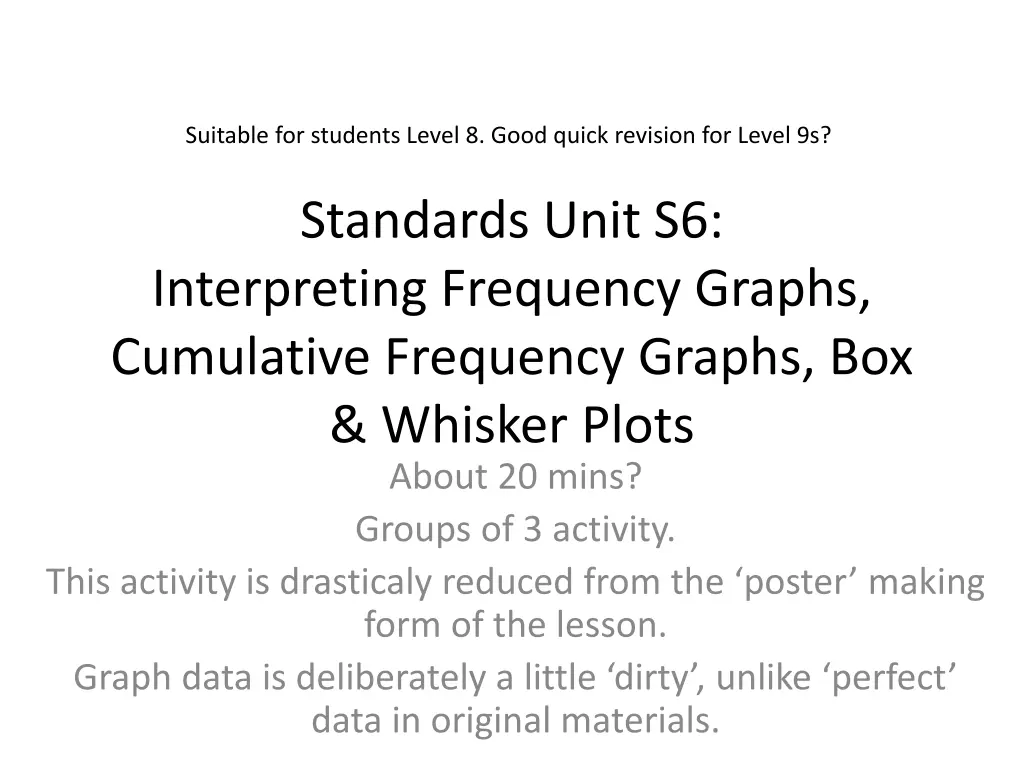
Quick Revision for Level 8 Students: Frequency Graph Interpretation
Engage students in a 20-minute session focusing on interpreting frequency graphs, cumulative frequency graphs, and box & whisker plots. This interactive activity is designed for groups of three and involves a card matching exercise with slightly imperfect data. Utilize the provided visual aids for a hands-on learning experience.
Download Presentation

Please find below an Image/Link to download the presentation.
The content on the website is provided AS IS for your information and personal use only. It may not be sold, licensed, or shared on other websites without obtaining consent from the author. If you encounter any issues during the download, it is possible that the publisher has removed the file from their server.
You are allowed to download the files provided on this website for personal or commercial use, subject to the condition that they are used lawfully. All files are the property of their respective owners.
The content on the website is provided AS IS for your information and personal use only. It may not be sold, licensed, or shared on other websites without obtaining consent from the author.
E N D
Presentation Transcript
Suitable for students Level 8. Good quick revision for Level 9s? Standards Unit S6: Interpreting Frequency Graphs, Cumulative Frequency Graphs, Box & Whisker Plots About 20 mins? Groups of 3 activity. This activity is drasticaly reduced from the poster making form of the lesson. Graph data is deliberately a little dirty , unlike perfect data in original materials.
Lesson development abandoned. Not enough good content here to bother. Just do session as a very basic card match. If possible, recommend actually using the official S.U. flipboard file, which allows manipulation of the cards on a smartboard. Then can partially build up completed pattern during mini-plenaries to help.
Card Match Solution (to be checked) Frequency Graph Statement Cumulative Freq Graph Box &Whisker This exam was much too difficult F E H This exam resulted in a huge spread of marks D F G This exam did not sort out the better-perf C B A Two groups of candidates.. E C E This was the sort of exam B H B In this exam, the mean mark was greater G D F In this exam, the median and the modal marks.., H A C In this exam, the mean mark was smaller A G D
Frequency Graphs A large number of students took an exam and their final scores are shown in the Frequency Bar Chart. Frequency Bar Chart What can we easily deduce? (i.e. work out)
Frequency Graphs A large number of students took an exam and their final scores out of 100 are shown in the Frequency Bar Chart. Frequency Bar Chart Frequency Line Graph When there are very many points on a bar graph like this, we usually represent the graph as a continuous line (even though the data itself is really discrete). It s easier to use, and to create.
Student Exam Results Frequency Line Graph Did the students find this exam easy, or hard? How can you tell? What was the modal score? Do you think the mean score was higher, or lower than the mode? Roughly how many students sat the exam?[quite hard to work out]
Frequency Tables to Frequency Graphs Usually, we start off with a Frequency Table, and then plot the graph. Frequency Line Graph But could we go backwards , and create the Table from the Graph? Frequency Line Graph Would it be easy and quick to do, or quite awkward?
Frequency Table Exam Score 0 1 2 3 51 70 Frequency ? ? ? ? ? ? ? ? ? ? ? Grouped Frequency Table Exam Score 0 - 10 11-20 21-30 31-40 41-50 51-60 61-70 Frequency Grouped Cumulative Frequency Table Exam Score 0 - 10 11-20 21-30 31-40 41-50 51-60 61-70 Frequency






















